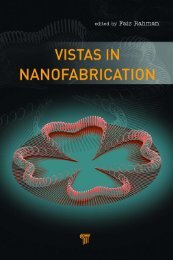Untitled - Pan Stanford Publishing
Untitled - Pan Stanford Publishing
Untitled - Pan Stanford Publishing
You also want an ePaper? Increase the reach of your titles
YUMPU automatically turns print PDFs into web optimized ePapers that Google loves.
To my mother and my father……because without their stimulus,encouragement, and persistence,I would have never gone so far
ContentsPrefacexiii1. Introduction 11.1 OLEDs: Background and Basic Facts 11.2 State of the Art 31.3 The Book: Contents and Organization 82. Organic Light-Emitting Devices: The Basics 112.1 The Organic-Led Basics 112.2 Approaches for OLED Organic Layers Structure 222.3 Methods for Processing Organic Semiconductors 312.3.1 Controlled Thermal Evaporation 322.3.2 Spin-Coating 342.3.3 Ink-Jet Printing 372.3.4 Self-Assembled Technique 392.3.5 Final Device Fabrication Considerations 413. Measuring the Electrical and OpticalProperties of OLEDs 433.1 Introduction 433.2 Carrier Injection and Transport in Semiconductors 453.2.1 Injection Limit: The Schottky Barrier atElectrode–Semiconductor Interface 463.2.2 Application of Schottky Barriers to OrganicSemiconductors: The Richardson–SchottkyEmission 503.2.3 A Special Case: Ohmic Contact 533.2.4 Injection Limit: The Tunneling Effect 543.2.5 Bulk Limit: Space Charge 563.2.5.1 Ohmic conduction 563.2.5.2 Trap-free SCLC 573.2.5.3 Trap-dependent SCLC: shallow levels 583.2.5.4 Trap-dependent SCLC: deep levels 603.2.6 Bulk Limit: Poole–Frenkel Effect 62
viiiContents3.2.7 Bulk Carrier Transport: The Hopping 643.2.8 Overview About Electrical Properties ofOrganic Semiconductors: An Attempt toUse the Common Models 663.3 Carrier Recombination and Electroluminescence 693.3.1 Carrier Recombination 693.3.2 Electrical Current and Electroluminescence 713.3.3 Light Generation 723.3.3.1 Electronic spectroscopy: the basicsof singlet–triplet organic molecularsystems 723.3.3.2 Luminescence advantages of metallo–organic complexes: the internalefficiency maximization 813.4 Characterization of the OLED Light Emission 833.4.1 Introduction and Light EmissionDrawbacks 833.4.2 OLED Light Measurements 843.4.3 OLED Efficiency Measurements 883.4.4 OLED Dynamic Emitting Region 954. Rare Earth Complexes:The Search for Quasi-Monochromatic OLEDs 1014.1 Introduction—The Choice of Rare EarthComplexes 1024.2 The Basics of Rare Earth Complexes:Application to Visible Spectrum 1034.2.1 The Structure of a Coordinated RareEarth (III) Ion 1044.2.2 Excitation and Luminescence Mechanismsof Rare Earth Coordinated Ions 1114.2.2.1 Basic principles of the luminescenceof coordinated rare earth ions 1114.2.2.2 Considerations about luminescenceefficiency and quenching ofcoordinated rare earth ions 1164.2.3 The Molecular Structure of a Rare EarthOrganic Complex and the “Antenna” Effect 1184.3 Rare Earth Based OLED: The Material
ContentsixChemical–Physical Properties 1274.3.1 Considerations of the Chemical–PhysicalProperties of the Rare Earth OrganicComplexes 1274.3.1.1 Rare earth common β-diketonatesand organic neutral ligands 1284.3.1.2 Excited energy levels of organicligands and rare earth ions: lookingfor the match 1324.3.2 The Photophysics of Rare EarthOrganic Complexes 1404.3.2.1 The general concept 1404.3.2.2 Absorption and emission spectra 1414.4 Rare Earth Based OLED: The Devices 1494.4.1 The Basic Structure 1494.4.2 General Cases of Rare Earth Based OLEDs:Europium, Terbium, Samarium, Thuliumand Dysprosium 1534.4.2.1 Europium-based OLEDs 1534.4.2.2 Terbium-based OLEDs 1644.4.2.3 Samarium-, thulium-, anddysprosium-based OLEDs 1714.4.2.4 Special cases of electrical carrierconfinement in rare earthbased OLEDs 1794.4.3 Special Cases of Rare Earth Based OLEDs:Energy Transfer from a Host Matrix 1824.4.4 Unusual Rare Earth Organic Complexeswith Applications of Interest 1954.5 Final Considerations about Rare EarthBased OLEDs 1975. Transition Metal Complexes:The Path to High-Brightness OLEDs 2095.1 Introduction—The Choice of the Transition MetalComplexes 2105.2 The Basic Transition Metal Organic ComplexSystems and Application to Light Emission 2125.2.1 Physical Structure of Different
















